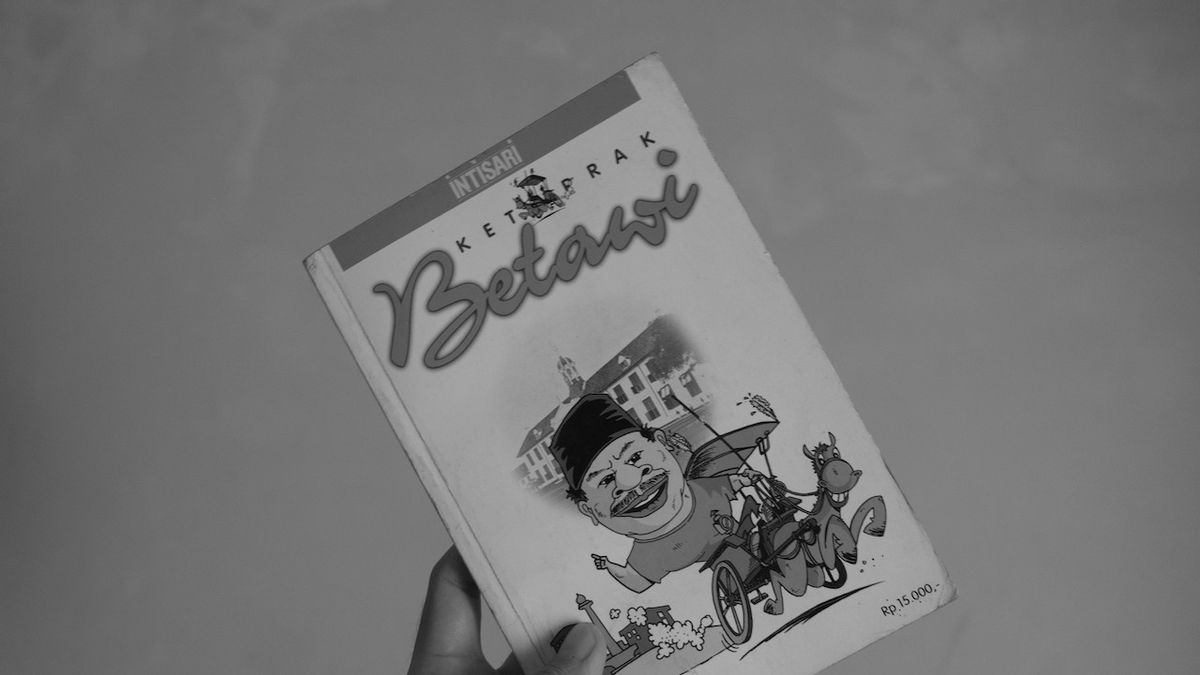JAKARTA - The capital city of Jakarta is an important place for the Indonesian people. A series of major historical events took place in this city. The early milestones of Dutch colonialism to Indonesian independence, for example. However, Jakarta is not only that. Another package of stories related to the past lives of people who lived in Jakarta is also interesting to discuss. There are funny and tragic stories. This description is present in the book Ketorpak Jakarta (2001).
The book is a collection of articles that have been published in Intisari Magazine since 1968. As a curator, Intisari Magazine selected 23 articles related to Jakarta from well-known authors, both domestic and foreign. Of course, with their respective capacities. Some of the names are Betawi cultural observer Ridwan Saidi, Dutch writer Justus van Maurik, Betawi Dictionary book writer Abdul Chaer, Augusta de Wit, and other names.
For that, the concoction of Intisari Magazine is so crunchy. Which, like a ketoprak dish with quite a variety of contents. There are stories of old Jakarta that are light in the past, and there are also those that have weight. Some are unique, and some are amazing. Therefore, all articles presented can enrich the knowledge of the readers.
Starting from the influence of the Betawi language on Indonesian, the complexity of old steam tram transportation, the lavish party in the style of the Governor General of the Dutch East Indies, to Jakarta, which has lost many quality monuments. Everything is presented so that readers can know that the history of Jakarta is not just black or white. Rather, history is colorful.
In that sense, Indonesia's past did not only include cases of Dutch oppression of the natives. However, many other things can be learned. Including, the mutual influence between the colonizers and us. Moreover, the case of the development of Jakarta from time to time is interesting to study.
The influence of the Betawi languageThe contribution of the Betawi language in Indonesian is quite large. to the point that, an Indonesian language expert had revealed that the Betawi language would replace the position of Indonesian in the 21st century. Its popularity was not accidental. This is because, the true Jakarta, which is the center of all national struggles, has sovereign Betawi language to become a popular language.
Ridwan Saidi in an article entitled Satan's Beauty, the Ancol, is not Mariam. Babe Ridwan (his nickname) noted that the Betawi language began to hit the print media thanks to the agility of the literary pen, Firman Muntaco. At that time, Firman, who was actively writing the column "Gambang Jakarte" in the Sunday News Newspaper from 1957-1965, was so liked by readers. This is because the Betawi language style adopted by Firman was included in the writing.
Because of that, Firman was able to break through the market share outside Betawi, so that the Betawi dialect began to be known rather widely in the archipelago. After Firman, the legend of Betawi acting, Benyamin Sueb, who carries the baton of the Betawi dialect, is known throughout the archipelago.
"Without hesitation, he revealed all Betawi expressions in his song, from the problem of nginjagituan, to the story of being hit by an aje again. There was nothing taboo in Bentamin's eyes, everything was smashed. People then feel liberated, so the Betawi language supporters are getting wider, ”written on page 3.
Demon train (Steam Tram)The presence of a steam tram in Jakarta around 1882 was a milestone in the progress of transportation in the archipelago. Uniquely, this title only lasted a short time. This is because steam trams are even considered the most modern and deadliest means of public transportation of their time.
At that time, the number of accidents caused by steam trams in Batavia was the highest. No kidding. The steam tram is dubbed as the biggest killer roaming the city of Betawi. In more detail, we have reviewed it in the article "There is no transportation more deadly than the steam tram in Batavia."
"You see, one day he (steam tram) killed him every four hours. The Betawi people like to joke and then use the initials NITM to make fun of them: Up is Sure to Die, "presented on page 124.
Citizens of Batavia often voiced criticism regarding the recklessness of steam trams on the roads. One of the most famous criticisms came from the former Batavia Finance Inspector LWJ Olivier (1887-1890). According to him, there was no other company in the Indies that shed so much human blood. People in Batavia also called it a "devil's carriage."
Dutch East Indies Governor General's Fancy PartyThe behavior of the Dutch settlers in Batavia can be said to be quite unique. If in their home country the Dutch are generally good at economizing, in the Colony this is not the case. The Dutch in the archipelago often lived a life of luxury. They love to show off, party hard, and are feudal. This attitude grew through the attitude of the governor-generals who were known to be generous and like to party.
This description was written by Justus van Maurik who had visited Batavia. As a guest of the Governor General of the Dutch East Indies, Carel Herman Aart van der Wijck (1893-1899), Justus was invited to join the dance party at Societeit Harmonie.
Because of that, Justus was not happy to play because the one who invited him was the number one person in Batavia. Properly, Justus was getting ready to prepare everything to be perfect in joining the dance. In full, we have reviewed it in the article "The Mad Party and Spree of the Governor-General of the Dutch East Indies."
“In front of the palace, which was brightly lit, large and small carriages lowered their passengers before sliding into the parking lot behind. When we entered, the reception room was full of guests. The interior is illuminated by a gas lamp in the form of a crown and candles from hanging candles. The garden is filled with colorful lanterns. If the temperature weren't so hot, we would feel like we were in a dance hall in Paris, with beautiful women dressed in brocade, satin, silk and sparkly jewelery, ”writes on page 58.
The loss of quality monuments in JakartaThe forced demolition of historical monuments has been going on for a long time in Jakarta. This act of vandalism has at least damaged the history of Jakarta itself. Allegedly, that action is a form of human reaction who does not think ahead. Moreover, the issue of monuments is not only a matter of small size or the beauty of the monument, but the historical meaning it contains.
The destruction of many historical monuments in Jakarta occurred during the transfer of power from the Netherlands to Japan in 1942. The Japanese reaction which began to establish power in the archipelago was marked by the destruction of one historical monument after another.
"The most victims are monuments of the Dutch colonial era. When the Japanese army occupied Betawi, statues of the gods Mars and Minerva, both of which were made of wood, were lowered from the gates of Kota Diamond to be burned, ”written on Page 142.
Presumably, that's what's interesting about the book Ketoprak Jakarta. Not only the description above, there are also other stories about old Jakarta, such as when Batavia was called the city of dung, the Tanah Abang market, the slaves in Batavia, and so on. Another advantage of books is that by reading this book, readers can reminisce to the past. At least, to know the history or popular places in Jakarta in the past.
Detail
Book Title: Ketoprak Jakarta
Authors: Ridwan Saidi, Abdul Chaer, Justus van Maurik, Augusta de Wit, et al.
First published: 2001
Publisher: Intisari Mediatama
Number of Pages: 180
The English, Chinese, Japanese, Arabic, and French versions are automatically generated by the AI. So there may still be inaccuracies in translating, please always see Indonesian as our main language. (system supported by DigitalSiber.id)









